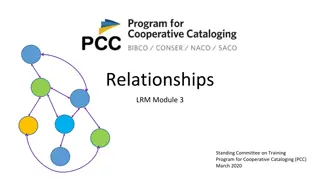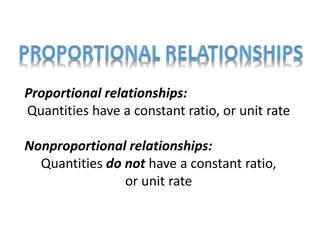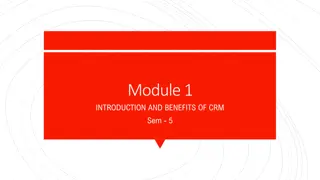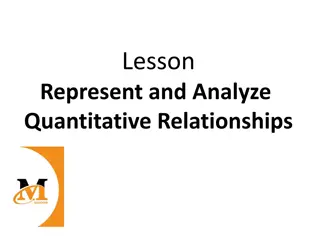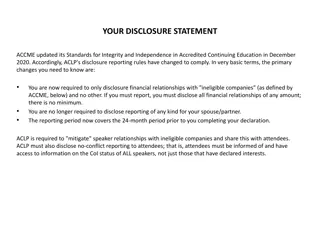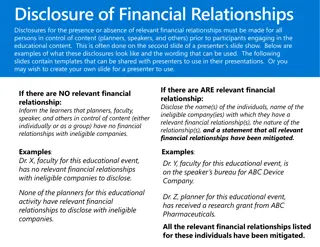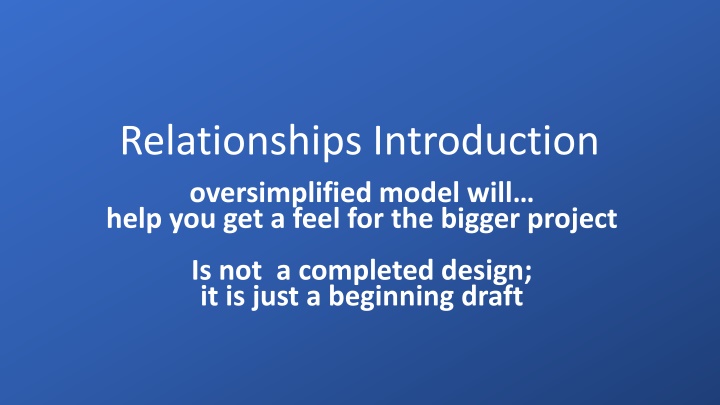
Exploring Relationships and Book Data Management
Dive into a simplified model for understanding relationships and book data management. Explore the concept of creating a basic book table and author table, tracking authors and publishers, and setting up raw data for analysis. Get a glimpse of organizing books, authors, and publishers in a systematic structure for efficient data handling.
Download Presentation

Please find below an Image/Link to download the presentation.
The content on the website is provided AS IS for your information and personal use only. It may not be sold, licensed, or shared on other websites without obtaining consent from the author. If you encounter any issues during the download, it is possible that the publisher has removed the file from their server.
You are allowed to download the files provided on this website for personal or commercial use, subject to the condition that they are used lawfully. All files are the property of their respective owners.
The content on the website is provided AS IS for your information and personal use only. It may not be sold, licensed, or shared on other websites without obtaining consent from the author.
E N D
Presentation Transcript
Relationships Introduction oversimplified model will help you get a feel for the bigger project Is not a completed design; it is just a beginning draft
Consider Four Books purchased 1. Could be the start of a personal library web site 2. need to know what is on hand and what is on order; web owner makes the claim that he only reviews book he owns and has read 3. Need to track all authors as individuals (not as teams) why? Because sometimes they don t write as a team
Connection table Orders Books Authors BookTitleID AuthorName ConnectionID AuthID OrdersID And we Need some attributes BookTitle BookTitle NumBooksOrdered OnShelf This suggests a books table authors table connection table orders table
Lets start entering some raw data even before we set up relationships start by entering the authors over and down
This one is on order The Memory Book Lorayne, Harry & Lucas, Jerry 1974 Ballentine $12.80 2 authors Grids and Page Layouts Amy Graver & Ben Jura 2012 Rockport $40.00 2 authors Miracle Math Lorayne, Harry 1974 Balentine $40.00 1 author? 0 author Fever 1793 Anderson, Laurie 2000 Aladdin Paperbacks $7.33 1 author
Authors: 1 Lucas 2 Lorayne 3 Anderson 4 Graver 5 Jura Books: 1 The Memory Book 2 Fever 1793 3 Miracle Math 4 Grids and Page Layouts Publishers: 1 Rockport 2 Aladdin Paperbacks 3 Ballentine Assume that we will Create additional first name field to differentiate authors with same last name Maybe I might want to track publishers. Its interesting that four books yields 3 publishers and 5 authors. We may need to add City, State, and Postal code if publisher has more than one location
Lets build a basic book table and author table
Connection table Books Orders Authors BookTitleID AuthorLName AuthID Book Title Book Title OnShelf OrdersID ConnID PK FK 1 Lucas 2 Lorayne 3 Anderson 4 Graver 5 Jura PK 1 The Memory Book 2 Fever 1793 3 Miracle Math 4 Grids and Page Layouts 1 1 1 0 1 2 3 4 5 6 1 2 3 2 2 4 5 FK 1 1 1 4 1 FK NumBooksOrdered 3 4 4 AuthID 1 Rockport 2 Aladdin Paperbacks 3 Ballentine Publishers PubID Country State City
BookTitleID AuthID Connection table Books Authors AuthorLName AuthID ConnectionID BookTitleID Book Title OnShelf 1 Lucas 2 Lorayne 3 Anderson 4 Graver 5 Jura 1 The Memory Book 2 Fever 1793 3 Miracle Math 4 Grids and Page Layouts 1 1 1 0 1 2 3 4 5 6 1 2 3 2 2 4 5 1 1 3 4 4 The connection table is pretty much the same as the one in our task 05 project This is not human readable, so lets dig into Access Relationships to build some lookup tables
To Set up Relationships Start with the Foreign Keys
Primary keys have gold key icon Foreign keys relate to other tables FK FK FK No FK FK No FK


